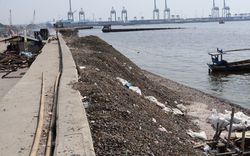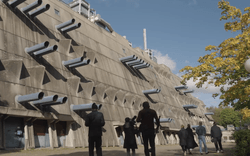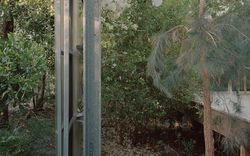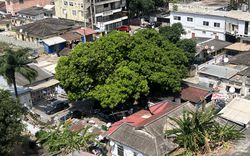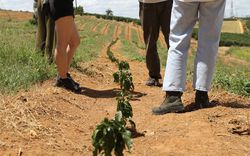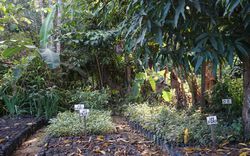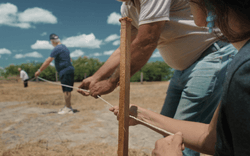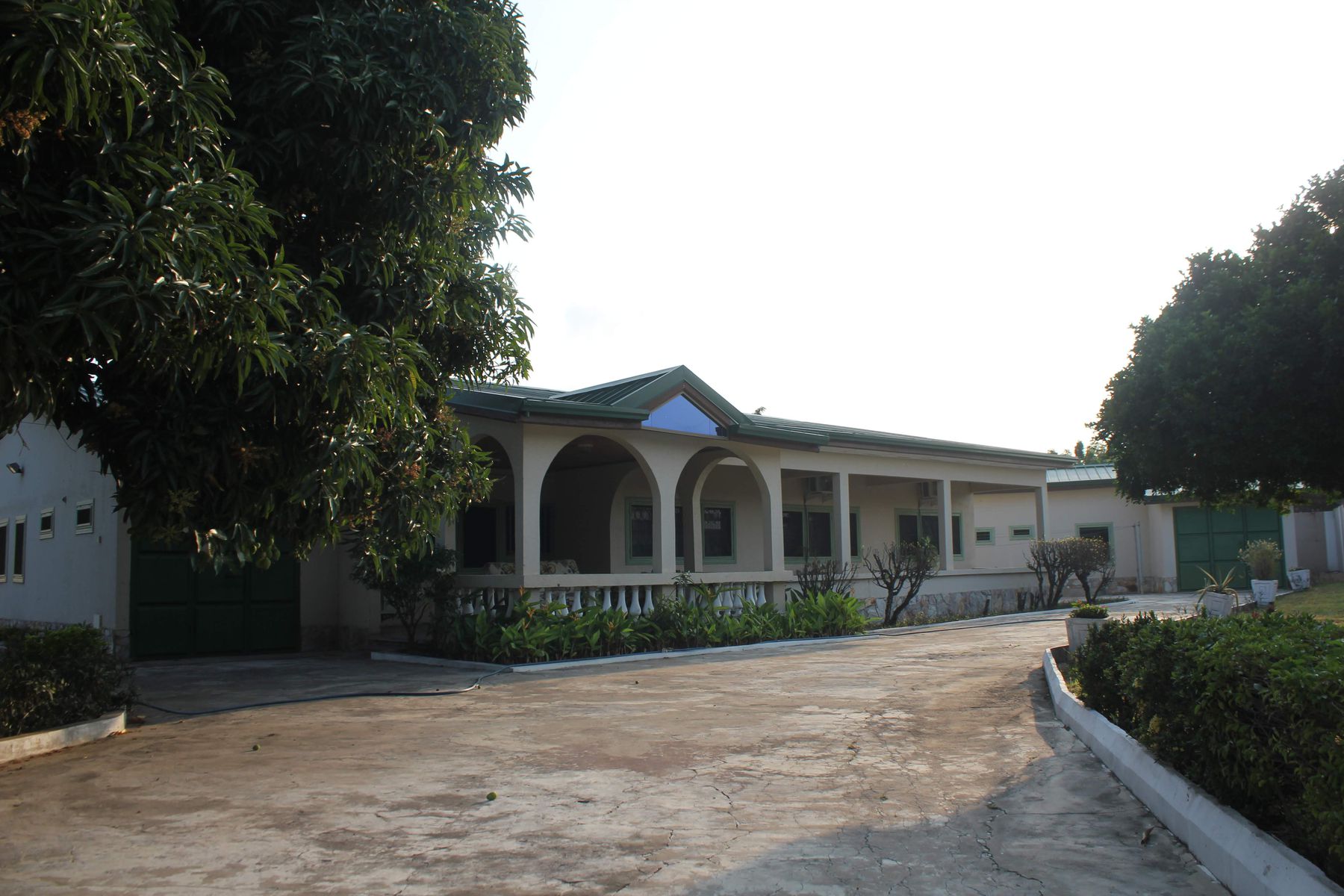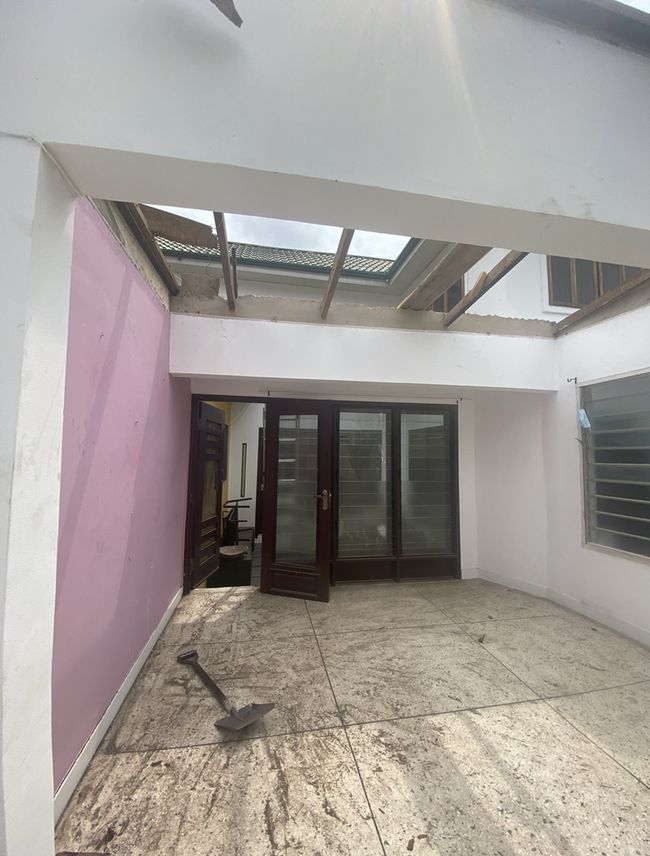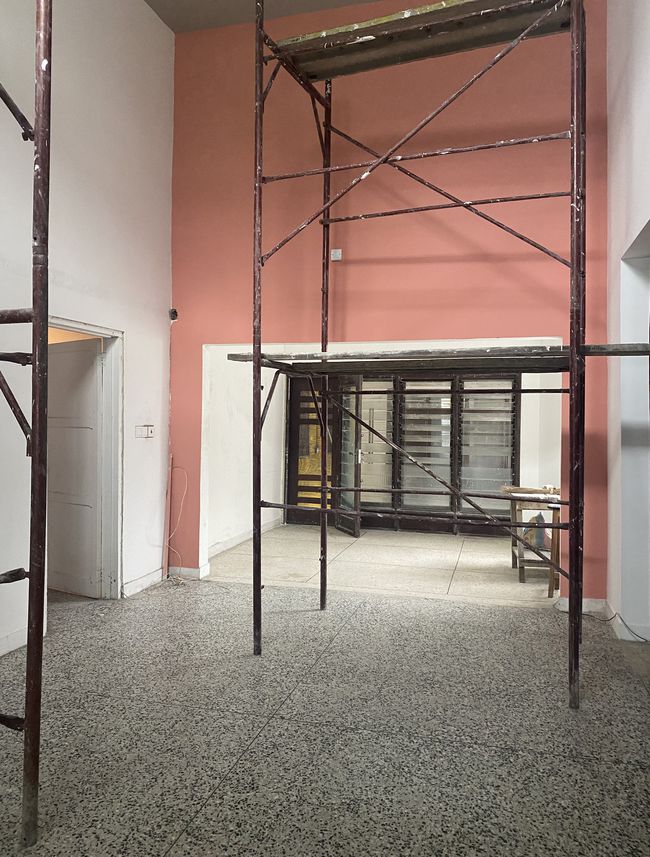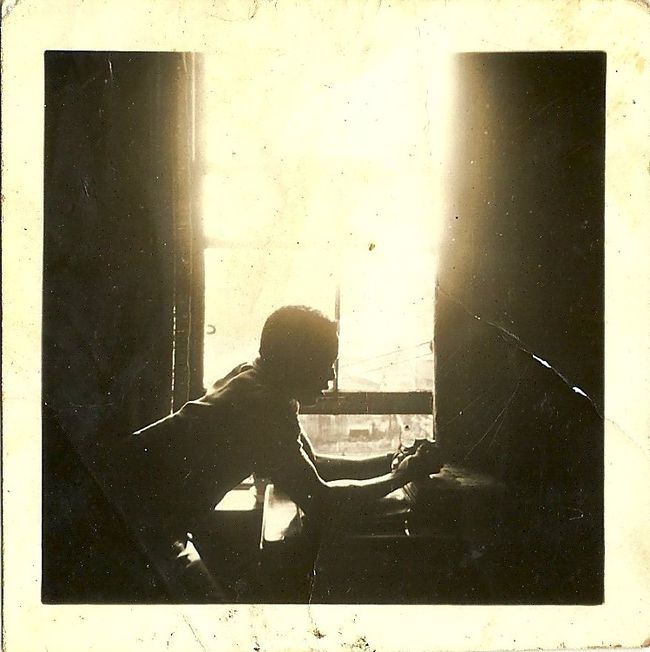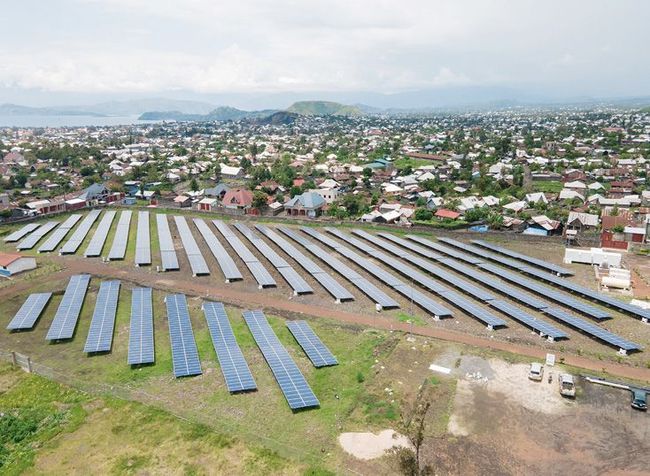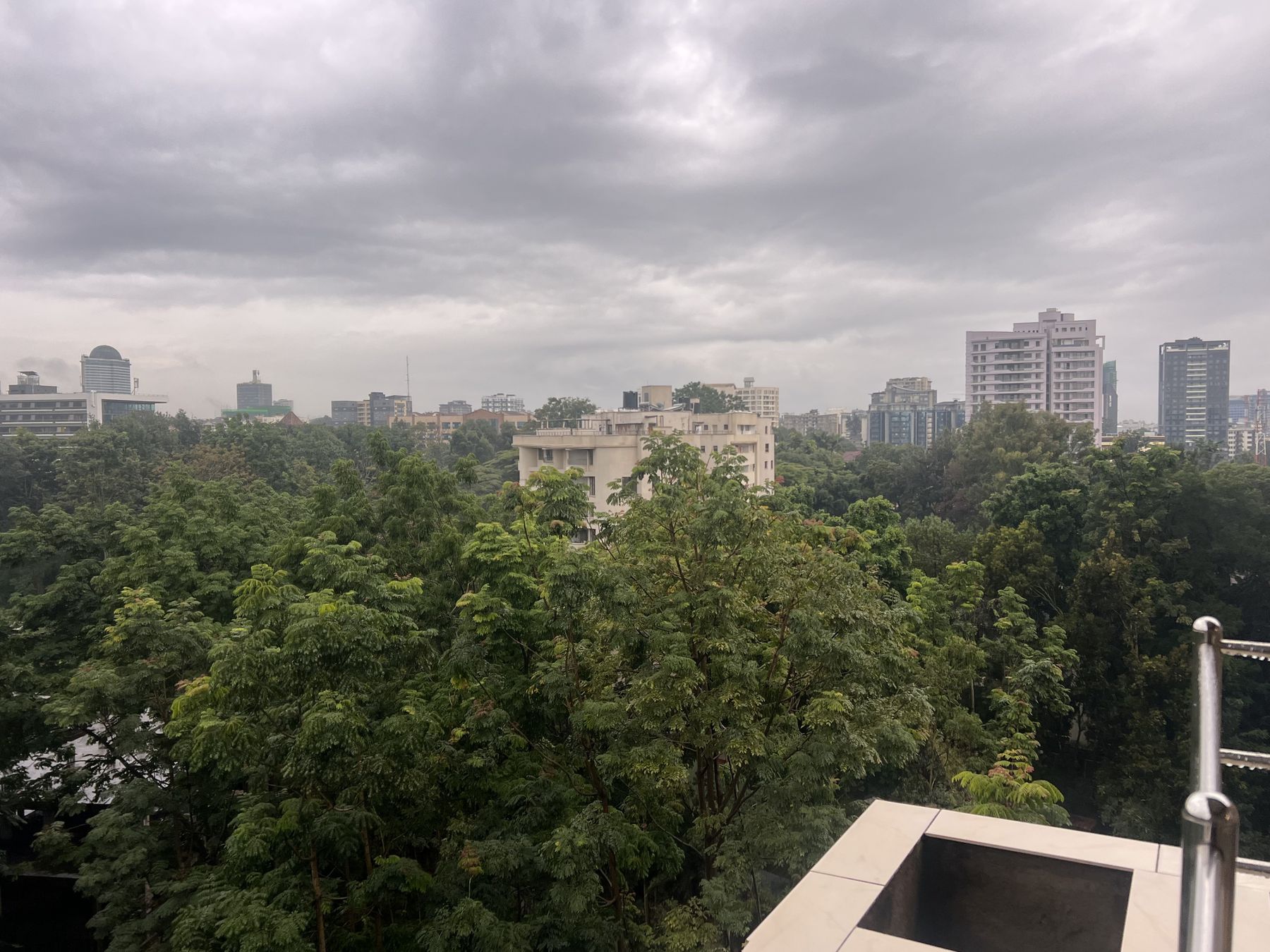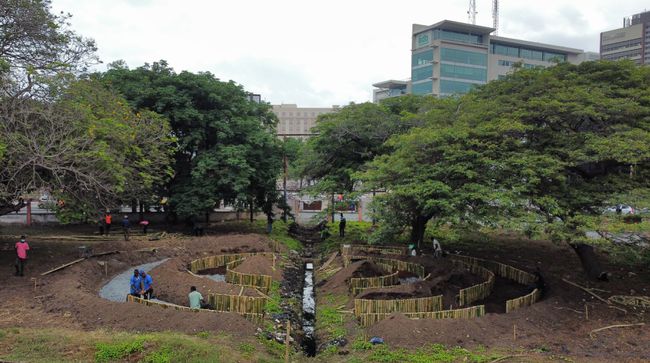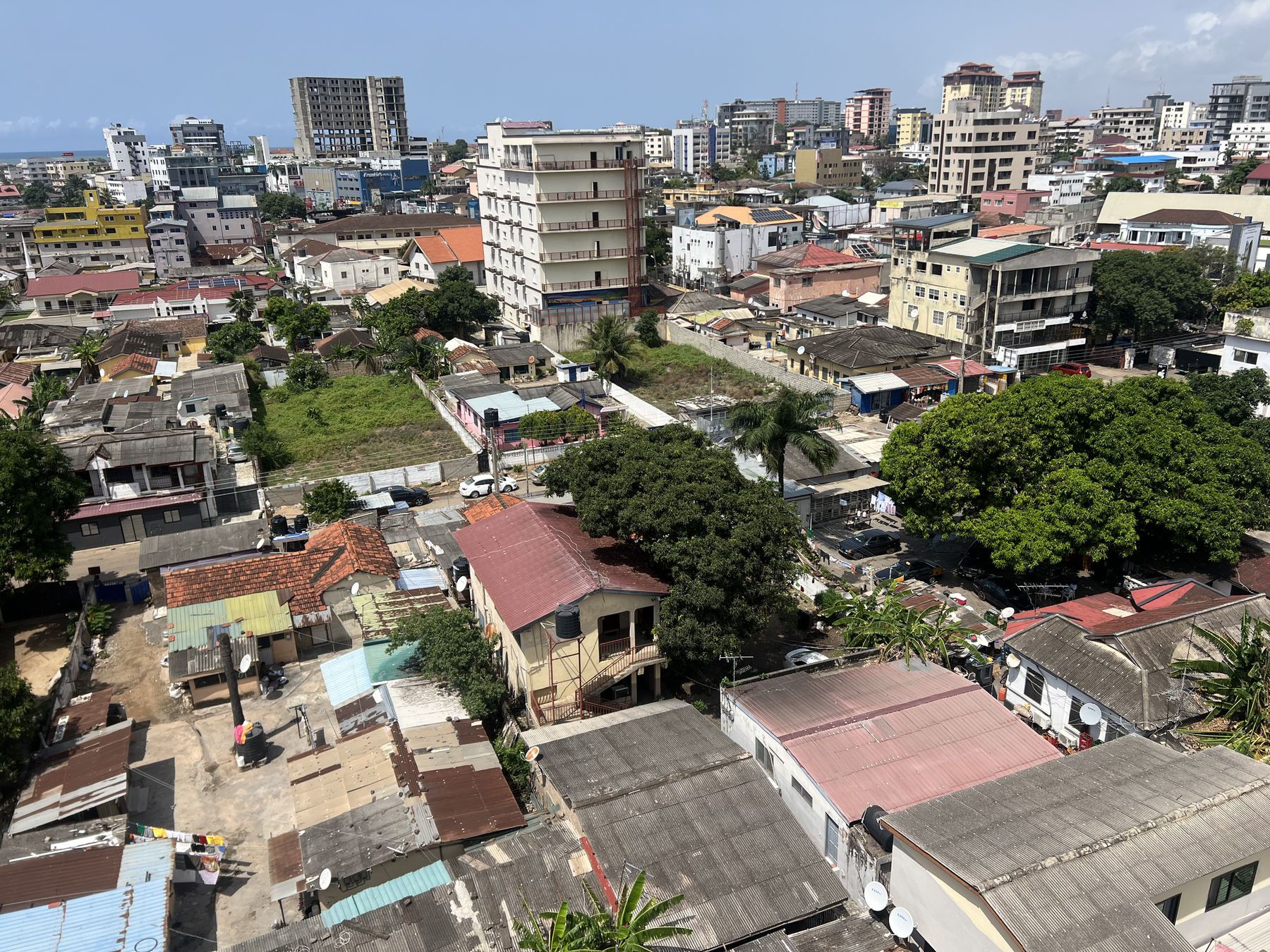Shooting the Breeze
Mae-ling Lokko and Elizabeth (Lizzie) Biney-Amissah on the interconnectedness of energy, materials, and rebuilding community
- Mae-ling Lokko
- It was so nice to visit you in your new home Nairobi. It reminded me of when you were working on your grandma’s houses back home in Ghana. How has the home-making process been different between Accra and Nairobi?
- Elizabeth Biney-Amissah
- My grandma roped me into renovating her two houses in Accra probably sixteen or seventeen years ago now. When I started, I thought it was going to be an easy, straightforward undertaking. They were two different houses built in two different moments in Ghana’s history: an older traditional bungalow with terrazzo floors and louvre blades, and the other a more modern house with plaster of Paris walls and ceilings, aluminum sliding windows, and tiles. At the time, I fought with my grandmother to modernize the older bungalow because optically I thought it looked better.
But now when I go home, I prefer to stay in the older house. That house just breathes. It has lungs. Air can come through the tongue and groove components, you can ventilate the entire window area with louvre blades. In Nairobi, I’ve been drawn to older buildings to live in, ones with big windows, lots of light, and hard floors. As I get older, I want things that are more connected with light, air, and the environment.
- MLL
- I totally hear you. My family moved from the Philippines to Ghana in 2000 into a bungalow with a huge garden. My father designed and built his house incrementally in the sixties or seventies. Sponsored by the Ghana Cocoa Board, he had been sent on a scholarship to study in Scotland and he was resettled back home with his Scottish wife and children. Like other men of his generation, he was bringing so many different worlds together, so many changes had happened within and around him culturally.
As a military surgeon at the time, with each paycheck he built another wall or room of the house. The house was a way for him to attempt to build his new world and life upon returning to Ghana with his family. I don’t know if he had all the spatial tools to do so but he did it anyway. Flash forward twenty or so years later when we moved back to live in that house. Despite some really nice louvres, shutters, and a verandah, the core of the house was not designed to allow good cross ventilation and daylight. Since I graduated college, I’ve spent a lot of time opening up and experimenting with the house—a project that never ends. Building our homes for access to good airflow is not something we think about a lot in our rapidly modernizing African cities until it’s too late. We think the air conditioners will solve it. When I think of the older homes with verandahs, shading and their material systems, they were designed to help your body adjust as you go in and out, I think we’ve lost that. - EBA
- Somebody asked me the other day, if I could go back to school, what would I be? I think I would’ve been an architect with a civil engineering minor because I love thinking about how people use space. I grew up in a family that has always welcomed people into our space. When my grandparents lived in a tiny apartment outside of Philadelphia, we still fit in fifty people a year for Thanksgiving. How space is constructed, how it’s used, all this informs our mood, how we interact, and who we are.
- MLL
- That makes me think of the occupational elasticity of the traditional compound houses in terms of who lived there and for how long. I remember reading that when the oil crisis happened in 1983, Ghana anticipated the deportation of a lot of Ghanaian citizens. They prepared emergency housing to accept the Ghanaian workforce living in Nigeria, and not a single one of them was occupied because everybody was absorbed into the family house system. It was basically our form of social security. And I’m aware our families have changed, and many of us leave for school or jobs at some point, and given how expensive housing is today we may come back and live with our family, or we may not. And so, what was once a very big house is now occupied by two aging parents or grandparents, who then need to earn income. Even though we are designing houses for smaller nuclear families, the size of this family unit still changes considerably. How are we designing to respond to unique dynamics of African homes and the changing family—from the flexibility of hosting extended family and guests to renting out sections of the house when the family shrinks?
Thinking about the work we’re doing today, around architectural material systems and energy, I find that we tend to think of them as two very things—one is a design problem and the other is a maintenance problem. But they’re incredibly connected. Do you see opportunities for bridging this gap? - EBA
- I think so. I like to tell this story about the first time my father came to visit me here in Kenya. One day, I caught him in an odd moment crying. And I’m like, dad, why are you crying? He’s like, when I was growing up, my reference point was the UK or the US. My dad was fifteen when Ghana became independent. And he said he could never fathom how beautiful Africa itself could be and that he wished that when he was younger, he had taken advantage of travelling the continent. And I start with that because I’ve travelled extensively across Africa for my work as a developer and as an investor in the energy space, and I see that we’re modernizing according to a Western context and importing materials that do well in other parts of the world. For many Ghanaians who have lived the UK, Europe, or North America, it’s very common for them to want the same aesthetic and comforts as they had when they were living there. The reference point of what we want is based off of what we’ve experienced outside, and then we import those ideas. They raid Home Depot and buy the same fixtures they had in their houses in the United States to use in Ghana.
After you’ve built this monstrosity of a home, you put air conditioning in every room. We build these homes and then we energize them. Houses built this way are effectively heat pumps. And when you zoom out on a neighbourhood scale, people living in the lower-class areas get the downwind of that heat and its deleterious effects.
I see my friends whose parents are passing land to them before they die, sometimes essentially with mega mansions, and the first thing they’re thinking is, how do I knock this down and put apartments or townhouses so that I can find the best use for the land? But what they’re not taking into account is foliage. You see these showhouses for new developments that are popping up all over Accra and none of them include more than shrubbery and some flowers. No backyard with grass, no trees. It’s all bricks or pavement blocks. You have ample space, but that space is filled with hard material. I feel like we look at nature now in terms of the cost of maintenance, ie. we can’t have grass because we’ll have to water it and water is expensive. So we use pavement blocks. Or you get a mango tree and it may interfere with your internet line or your electricity lines, so it’s just better to cut the tree. If we’re going to talk about merging these silos, we have to go back to the basics of what it is to live on this Earth. We share this planet with other animals and other beings, but we’ve become very selfish. The dominant frame of mind is, “I need to build this for me and mine and to hell with what it does to everybody else.” I think that’s at the crux of how we’ve gotten here.
- MLL
- That’s definitely the prevailing mindset. It also makes me think of how we’ve lost an understanding of seasonal patterns and the land we live on, for example we have forgotten or ignored how rivers traverse our landscapes. So we build in its way, and put all these vertical impermeable surfaces, walls, pavements, so the water has nowhere to go but accumulate in areas that really make the most vulnerable in our society even more in peril. There are decreasing soil ecosystems with plants and fungi that can capture, slow down, temporarily store, and eventually clean the water. Being in Kenya, it was inspiring to experience the amount of green around me—and the shift in quality of life that that brings.
I feel the creation of a healthy environment has a lot to do with rebuilding community. More recently, I’ve been thinking a lot about the fact that I don’t know my neighbours. If there was some type of climate disaster, we don’t have a social infrastructure that allows us to weather the storm. Ghanaians are known to be very hospitable. We have strong ties historically, but those bonds are loosening or withering away as family structures and dynamics change. And building community is difficult work, you need time and resources to invest consistently in each other. But the lack of these bonds to each other and to place is at the end of the day the reason people leave places. How do we do that once again, especially as it’s become impossible for young generations to afford housing? - EBA
- Echoing your sentiments around community, it’s something I talk to my sister about a lot. She’s a doula and she talks about her work with birth equity, and the reason she became a doula was because in communities, we used to have grandmothers and aunties and all of these women that could come around and mentor us. Over time with migration, slavery, and colonialism, that sense of community across the diaspora broke down. So having somebody to advocate for you, whether you’re in the hospital or you’re being treated elsewhere, is so important. And I think it lends itself nicely to the work I do. I always tell people I fell into energy work by accident.
What I have learnt in the work I do is that energy is the building block of economies, of countries, and of basically everything. I used to work for this company called Nuru. With the advent of off-grid electricity and distributed renewable energy, Nuru’s founder, Jonathan Shaw, had the idea to build a metro-grid in Goma, in eastern DRC. Watching this small town of Goma, powered by essentially this 1.5-megawatt grid with inflows from nearby smaller grids, come to life and become productive, that is the essence of energy for me.
Let’s say a community farms tomatoes: instead of them shipping raw tomatoes to the main market and 67% of that being lost because it was never put in cold storage, it’s possible they could still sell a percentage of fresh tomatoes, but they could tin a bunch of it, and they could build a factory. That factory could develop value added processing that retains the commodity, creates jobs, and is the underlying offtake for the community to have that grid. That’s probably what makes me most excited about continuing to work at energy access and energy transition. The need for power is clear, the question is how we organize it and make sure people are using it.
- MLL
- The question of energy is not at all separate from architecture, and I think there’s this question around scale and timing in your work with Nuru that I find very compelling. Here comes a big industry player who is consistently going to consume a certain amount of energy at a certain point in the day, and smaller residential players who need energy at a different point in the day. The big player has the capital to build the baseline infrastructure for a mix of energy types and consumers. Instead of putting a cap on growth and energy access, how do you design for a mix of energy sources (renewable and non-renewable) and match this to different consumers, their energy needs and purchasing capacities?
It’s inspiring to think of Goma’s energy independence and its productivity. When I think of all the different ways we waste energy today, it’s scary. How do we essentialize the things that truly need high grade energy (electricity), and allow thermodynamics to create heating and cooling in our buildings? That’s so much work that we can offload from our energy systems.
Part of it is understanding how we use energy: what are the behaviours driving energy use in African cities? In architecture, when we do an environmental simulation of how a building is going to deal with heat, we use basic assumptions in building energy models that consistently miss the mark when it comes to energy consumption in Africa. For example, we don’t put on an AC just because it’s above a certain temperature outside; we put on an AC when the guests come over because we’re trying to save face or show that we’re well off! And we closely regulate electricity consumption based on the cost of electricity. So what are these behaviours that really determine how energy is used at a domestic scale? - EBA
- I think it’s a great question. As we develop our electricity markets, hopefully we move closer to a wholesale market where we’re always dispatching the cheapest and the lowest impact generation capacity. But what’s more important is that we move to a spot market where we’re reacting to pricing based off of demand and supply. I think you’re entirely right that we are sensitive to pricing in the sense that if the family is home, we’re all sitting under a fan and the windows are open. It’s when somebody comes over that we pull out the soda and ice and we turn on the AC. There are paradigms in places like Sweden where we see the use of actual policy to change behaviour. So if it is simply that you get a rebate for how you’re using electricity, or there are price peaks and troughs during the day, I think we could see people changing their behaviour to match what their budget is and what their patterns and what their needs really are.
- MLL
- I feel like there are so many parallels in the building materials sector. Just for context, at Yale where I teach and direct doctoral research, we were working with a team of global collaborators on understanding the carbon footprint of today’s building material sector. Our goal was to explore both the decarbonization of conventional building materials and scale up low carbon renewable building materials between now and 2060. Alongside the larger study, we had a Sub-Saharan region case study, looking at Ghana and Senegal. Both are two rapidly developing West African countries. They are not the largest, but the offer key trends for medium scale, politically stable and rapidly developing economies in the region.
In both contexts you see how exterior walls of all housing typologies have shifted from earth masonry to concrete masonry, and away from insulative fibrous roofs to metal roofs. In Senegal where it’s hot and dry, you’ll also see a lot of flat roofs being converted into concrete blocks. Even though we have emerging high-quality, low-carbon building materials, it’s very difficult to get people to buy into these products for many reasons. Some have to do with today’s ease of access and comfort. You can find masons everywhere who know how to work with concrete masonry and metal roofing. Others revolve around historical memories around maintenance, water damage, and cost. A lot of our vernacular technologies—earth masonry, thatch—have historically required a lot of skill, community labour, and time. All this is reflected in the upfront costs. But once this is solved by scaling, standardization, and training, how do we expand what African city dwellers want in terms of their materials? Because people do want interesting materials. You see it in the choices we make with our tiles and our facades, it’s a way of projecting social identity. I’ve tried to celebrate these ambitions and dreams in the design of our building material products, but there’s a lot more work to do there.
Just like your project in Nuru using off-grid electricity and distributed renewable energy, I think in the building materials sector, there’s an opportunity for low-carbon renewable materials to partner with today’s conventional mineral and metal building material industries. For example, can cement industries start to source fly ash from agriculture to reduce the amount of cement binder that we need? And by having a consistent buyer for agricultural residues, that allows us to build equipment, green-skill the labour force, and start to scale low-carbon materials.
- EBA
- You know, as I think about getting older, I want to live in a place that’s green. I want to be able to breathe clean air, to be able to eat fresh fruit and vegetables from my own garden or a community garden and have it taste like it’s supposed to taste. And I also want a space that calls people in. That’s very much part of my DNA, fellowshipping with people and creating community. I’d love for my kids to grow up in a healthy environment. I’d love for there to be openness within my community.
You mentioned not knowing your neighbours. We did have a flood in our house in Accra about three weeks before I left for grad school in 2015. The walls fell down between our neighbours. I could see three houses down in each direction, and one of the houses next door had goats who would jump over the little boundary and come and eat in our garden. But we had to talk to our neighbours and share the cost to rebuild walls. I would say now the people on my street are tighter, but my family’s lived on that street for sixty years. So we do need to live in a world where we take care of each other.
Being in the Global South, we are disproportionately affected by climate change, having not contributed to it in its current state. And we’re forever being asked to be the ones to transition before we even get a leg up. So it has to be more equitable. We are young countries in the Global South still trying to build the basic infrastructure. Finding the balance between what we need, what is sustainable, and what is overall going to be better for everybody has to be a partnership between the developers, quantity surveyors, architects, and the people that are going to be managing the municipality or the city. We can only do this together, but we have to break these silos to see how everything affects the other thing. What about you, what’s the ideal place looking like for you in the near future? - MLL
- I mean, the times we’re living in now make me want to have a home in a community of people who care for each other. I remember my father talking about when he was growing up in Osu, in Accra, where dinner was with your cousins and neighbours, and someone was always looking out for you as a kid on the street. So maybe it’s a back to the future kind of thing. But I would love to address what I think many of us around the world feel in terms of loneliness in cities. How do we start to grow and cultivate the kinds of relationships that can stand the test of time as well as the climate and political events that we’re going to see happening again and again? And physically and psychologically, I want to see biodiversity and a tactility of materials, because I think that there’s just so much more that can enrich and enliven our cities. But I think that needs, as you said, to be democratized.
- EBA
- You’re right, we need to think about how we’re building this world. We think about how we just keep building walls higher and higher and we don’t know our neighbours. When I first came to Ghana as a child, we had razor wire, but in between that we had broken soda glasses that were embedded in the top of the wall. It’s cynicism around other people wishing you harm or doing you harm. I think these things all contribute to the fact that we are just falling further and further apart and not thinking about each other.
- MLL
- Which goes back to the fabric of community, that there are these bonds and ways of communicating when we’re in trouble, when we need help, when we need resources, because ultimately it affects all of us.
- EBA
- In whatever we deem we need to build, we need to think about equity. It’s equity of resources, equity of opportunity, equity of access to so many things. I think there’s an audacity of low expectations sometimes when we talk about energy access. Why is it that we think it’s enough to give somebody a solar panel so they can only charge a radio or maybe a phone? Todd Moss, who writes a blog called Eat More Electrons, talks about the audacity of low expectation when it comes to development and what we accept to build for the people at the bottom of the pyramid as if we’re doing them a favour, when in fact the world has more than enough resources and money for every single soul on this Earth.1
- MLL
- Absolutely. And this is where a much more liberatory paradigm in terms of conditioning space comes in, one where nature in cities plays a role and where architecture is a form of public health infrastructure. In contrast to relying on and becoming addicted to mechanical cooling in our homes and offices, we don’t always have to have our air conditioned to 17 degrees Celsius. We aren’t meat in the refrigerator, we are active, living beings with the capacity to move, sweat, and regulate our comfort.
- EBA
- Yeah, we don’t need that. When you ask Uber drivers in Ghana, do you have AC? They’re like, what are you, a frozen chicken?
- MLL
- [Laughter] The more we subject ourselves to those conditions for longer periods of time, the more intolerant we’re going to be. We’re not doing our bodies any favours. So, I fully agree with you, we need much more imaginative approaches to thinking about energy and materials, because we want these options from and for the world around us.
-
Todd Moss, “The soft bigotry of low expectations,” Eat More Electrons, April 17, 2024, https://toddmoss.substack.com/p/the-soft-bigotry-of-low-expectations. ↩

